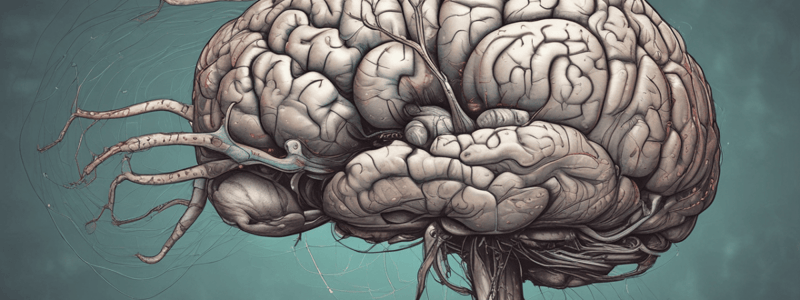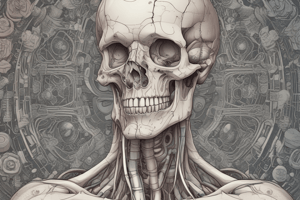Podcast
Questions and Answers
Which center in the medulla controls the rate and rhythm of breathing?
Which center in the medulla controls the rate and rhythm of breathing?
- respiratory rhythmicity center (correct)
- apneustic center
- pneumotaxic center
- cardiovascular center
How many cranial nerves have their nuclei in the medulla oblongata?
How many cranial nerves have their nuclei in the medulla oblongata?
- 7
- 3
- 5 (correct)
- 12
What is the primary function of the substantia nigra in the midbrain?
What is the primary function of the substantia nigra in the midbrain?
- expressing acetylcholine
- expressing noradrenaline
- expressing serotonin
- expressing dopamine (correct)
Which structure connects the 3rd and 4th ventricles in the brain?
Which structure connects the 3rd and 4th ventricles in the brain?
Which part of the brain acts as a bridge connecting the spinal cord with the brain?
Which part of the brain acts as a bridge connecting the spinal cord with the brain?
Which group of neurons in the pons acts like an 'off-switch' to terminate medullary inspiratory activity?
Which group of neurons in the pons acts like an 'off-switch' to terminate medullary inspiratory activity?
What is the primary function of the Reticular Activating System (RAS)?
What is the primary function of the Reticular Activating System (RAS)?
Which type of neuron is found in the cerebellum?
Which type of neuron is found in the cerebellum?
What is a key function of the cerebellum?
What is a key function of the cerebellum?
Which disorder is associated with dysfunction in the Raphe nuclei?
Which disorder is associated with dysfunction in the Raphe nuclei?
Where do the neurons of the diffuse modulatory systems primarily arise?
Where do the neurons of the diffuse modulatory systems primarily arise?
What chemical is released by the serotonergic neurons of the Raphe nuclei?
What chemical is released by the serotonergic neurons of the Raphe nuclei?
Which system is associated with the prevention of sensory overload?
Which system is associated with the prevention of sensory overload?
Which area releases transmitter molecules into the extracellular fluid, according to the principles of the diffuse modulatory systems?
Which area releases transmitter molecules into the extracellular fluid, according to the principles of the diffuse modulatory systems?
Which serotonin receptor is not a G-protein coupled receptor (GPCR)?
Which serotonin receptor is not a G-protein coupled receptor (GPCR)?
Which type of drug is Sumatriptan classified as?
Which type of drug is Sumatriptan classified as?
Which of the following is used to treat generalised anxiety disorder (GAD)?
Which of the following is used to treat generalised anxiety disorder (GAD)?
Which drug is a D2 agonist and is sometimes used to treat Parkinson's disease?
Which drug is a D2 agonist and is sometimes used to treat Parkinson's disease?
What neurotransmitter's transporter is inhibited by Fluoxetine?
What neurotransmitter's transporter is inhibited by Fluoxetine?
Which brain region is associated with the control of breast milk production through dopamine regulation?
Which brain region is associated with the control of breast milk production through dopamine regulation?
Which condition is associated with the degeneration of dopamine neurons in the substantia nigra?
Which condition is associated with the degeneration of dopamine neurons in the substantia nigra?
Which drug is used as an antagonist at D4 receptors to treat schizophrenia?
Which drug is used as an antagonist at D4 receptors to treat schizophrenia?
What is the primary function of the thalamus?
What is the primary function of the thalamus?
Which structure is primarily responsible for maintaining homeostasis?
Which structure is primarily responsible for maintaining homeostasis?
Where is the diencephalon located?
Where is the diencephalon located?
Which body functions are regulated by the nuclei in the medulla oblongata?
Which body functions are regulated by the nuclei in the medulla oblongata?
What role does the hypothalamus play in the Autonomic Nervous System (ANS)?
What role does the hypothalamus play in the Autonomic Nervous System (ANS)?
What does the medulla oblongata contain that extends between the spinal cord and cerebrum?
What does the medulla oblongata contain that extends between the spinal cord and cerebrum?
What is one of the hypothalamus's functions in relation to body temperature?
What is one of the hypothalamus's functions in relation to body temperature?
What form of sensation is not processed in the thalamus before reaching the cerebral cortex?
What form of sensation is not processed in the thalamus before reaching the cerebral cortex?
Which adrenergic receptor sub-types are metabotropic and coupled to different G-proteins?
Which adrenergic receptor sub-types are metabotropic and coupled to different G-proteins?
What is an example of a mixed noradrenaline-serotonin reuptake inhibitor?
What is an example of a mixed noradrenaline-serotonin reuptake inhibitor?
What is the effect of reserpine on noradrenaline levels in synaptic vesicles?
What is the effect of reserpine on noradrenaline levels in synaptic vesicles?
Which neurons are impacted by cholinergic activities for reward systems?
Which neurons are impacted by cholinergic activities for reward systems?
Where do the axons from the nucleus basalis and medial septal nucleus go?
Where do the axons from the nucleus basalis and medial septal nucleus go?
Which disorder is associated with impaired cholinergic neurons in the brain?
Which disorder is associated with impaired cholinergic neurons in the brain?
What is the role of selective noradrenergic reuptake inhibitors (NRIs) in the CNS?
What is the role of selective noradrenergic reuptake inhibitors (NRIs) in the CNS?
What are the primary functions of the noradrenergic system in the CNS?
What are the primary functions of the noradrenergic system in the CNS?
Flashcards are hidden until you start studying
Study Notes
The Brain Stem
- The brain stem is superior to, but continuous with, the spinal cord
- It is made up of:
- The midbrain
- Pons
- Medulla oblongata
The Medulla Oblongata
- The medulla begins at the inferior border of the pons and extends to the foramen magnum (~3 cm)
- It contains all ascending and descending tracts extending between the spinal cord and cerebrum
- The medulla contains nuclei which are regulators for various vital body functions
- Vital functional centers regulated by the medulla include:
- The cardiovascular center - controls the rate and force of heartbeat, and the diameter of blood vessels
- The respiratory rhythmicity center - controls the rate and rhythm of breathing
- The vomiting, coughing, and sneezing centers
The Pons
- The pons lies directly above the medulla and anterior to the cerebellum
- It acts as a bridge connecting the spinal cord with the brain and parts of the brain with each other
- Together with the medulla, areas in the pons help control breathing
- The pontine respiratory group is normally inactive during quiet breathing
- This group of neurons acts like an "off-switch" to terminate medullary inspiratory activity
The Midbrain
- The midbrain extends from the pons to the diencephalon
- The cerebral aqueduct passes through the midbrain connecting the 3rd ventricle above with the 4th ventricle below
- The midbrain contains several other nuclei, including:
- Substantia nigra (dopamine expressing neurons)
- Raphe nuclei (serotonin expressing neurons)
- Locus coeruleus (noradrenaline expressing neurons)
- Pedunculopontine nucleus (acetylcholine expressing neurons)
The Reticular Formation
- The Reticular Activating System (RAS) functions to maintain consciousness, a state of wakefulness in which an individual is fully alert, aware, and oriented
- Inactivation of the RAS produces sleep, a state of partial consciousness from which an individual can be aroused
- The RAS also prevents sensory overload by filtering out insignificant information
The Cerebellum
- The cerebellum or "little brain" is the second largest part of the brain and lies inferior to the cerebrum and posterior to the brain stem
- The type of neuron within the cerebellum is the Purkinje neuron
- Important for:
- Unconscious motor coordination
- Emerging functions such as cognition and emotion
- Diseases associated with cerebellum dysfunction include:
- Autism
- Ataxia
- The cerebellum is an important target for alcohol
Serotonin (5HT)
- 13 known 5HT receptors in humans
- Divided into 7 classes (5HT1-7)
- Also divided into sub-classes e.g. 5HT1A
- All are G-protein coupled receptors (GPCRs) apart from 5HT3 (which is an ionotropic receptor)
- Activation of some of the 5HT GPCRs results in neuronal inhibition (5HT1-2) and some result in neuronal excitation (5HT4-7)
- The effect of 5HT on a neuron depends on what 5HT receptor is expressed on that neuron
Clinical Pharmacology of 5HT receptors/systems
- Buspirone; gepirone: partial agonist at 5HT1A receptors
- Used to treat generalized anxiety disorder (GAD)
- Sumatriptan (and other Triptans): agonists at 5HT1B receptors
- Used to treat migraine headaches
- Clozapine; Risperidone; olanzapine: antagonists at 5HT2A receptors (also antagonist at Dopamine 2 Receptors)
- Used in the therapy of psychosis (e.g. Schizophrenia)
- Odansetron; Granisetron: antagonists at 5HT3 receptors
- Used as antiemetics
- Fenfluramine: stimulates reversible transport of 5HT into the synapse => more SHT in synapse => more 5HT available to act on receptors
- Used as an anti-obesity agent
- Selective serotonin reuptake inhibitors (SSRIs) e.g. Fluoxetine: block the 5HT transporter => more SHT stays in the synapse
- Used to treat depression
Dopamine (DA)
- Major DA Nuclei:
- Substantia nigra (SN) - voluntary movement
- Ventral tegmental area - motivation; cognition; reward
- Hypothalamus - control of breast milk production
- The effect of DA will vary depending on brain regions
- Major brain disorders associated with impaired DA regulation:
- Parkinson's disease (SN DA neurons die)
- Psychosis (schizophrenia)
- Addiction
- Hormonal disorders
DA Receptors
- Five receptors in total named: D1, 2, 3, 4, 5
- All are G-protein coupled receptors (GPCRs)
- Functionally, they are divided into: the D1 family (D1 & D5) & D2 family (D2-3-4)
- DA receptor activation can result in neuronal excitation or inhibition depending upon the G-proteins they are coupled to
DA pharmacology
- L-dopa: precursor to Dopamine. When it enters the CNS, it is converted to DA. The result is increased DA levels in the brain.
- Used in the treatment of Parkinson's disease
- Bromocriptine: D2 agonist
- Sometimes used in the treatment of Parkinson's disease
- Used in the treatment of hyperprolactinaemia
- Haloperidol: D2 antagonist
- Used in the treatment of schizophrenia
- Clozapine: antagonist at D4 receptors
- Used in the treatment of schizophrenia
- Cocaine: inhibits the dopamine transporter (also noradrenaline)
- Used in the treatment of schizophrenia
Noradrenaline (NA) in the CNS
- NA pharmacology in the CNS:
- Alpha (1-2) & Beta (1-3) adrenergic receptors
- Alphas further divided into sub-classes (Alpha1A, Alpha1B, Alpha1C, Alpha2A, Alpha2B, Alpha2C)
- All are metabotropic coupled to different G-proteins
- Noradrenergic transmission in the CNS important in:
- the 'arousal' system, controlling wakefulness and alertness
- blood pressure regulation
- control of mood (functional deficiency contributing to depression)
- Selective noradrenergic reuptake inhibitors (NRIs) inhibit the NA transporter => more NA left in the synapse used as antidepressants e.g. bupropion, reboxetine, atomoxetine
- Mixed noradrenaline-serotonin reuptake inhibitors (SNRIs) e.g. Venlafaxine => more serotonin and NA left in the synapse
- antidepressants
- Psychotropic drugs that act partly or mainly on noradrenergic transmission in the CNS include:
- Cocaine
- Amphetamine
- Reserpine: VMAT inhibitor => depletes the amount NA in synaptic vesicles => decreased NA released into the synapse. => its use can induce depression
Acetylcholine
- Major Ach nuclei in the CNS:
- Nucleus basal (Basal Nucleus)
- The medial septal nucleus and Diagonal band
- #1 & #2 send axons to the cortex => important for arousal; emotion; cognition
- Pedunculopontine nucleus (in the brainstem) => sends axons to dopamine neurons of the VTA => important for reward systems
- Diseases associated with Ach dysfunction:
- Impaired cognition and memory (Cholinergic neurons die in Alzheimer's disease)
- Mood disorders e.g. Depression
- Motor coordination
Studying That Suits You
Use AI to generate personalized quizzes and flashcards to suit your learning preferences.




